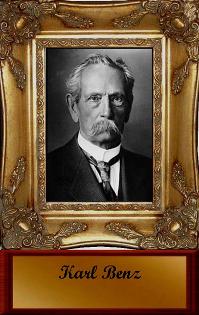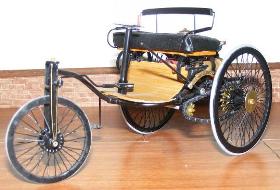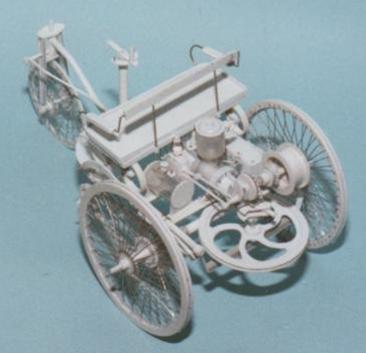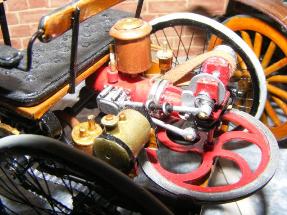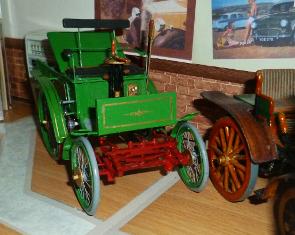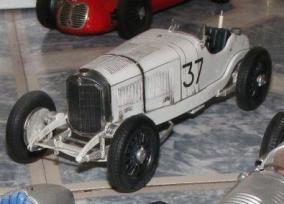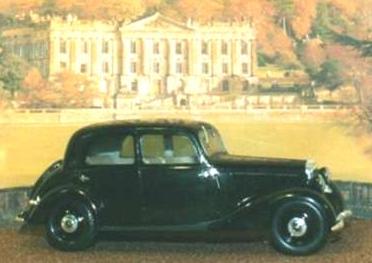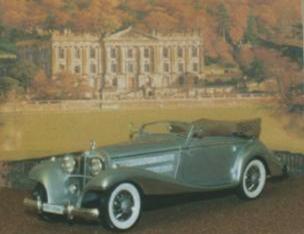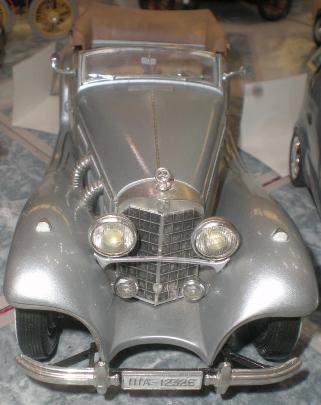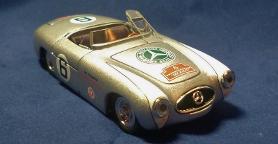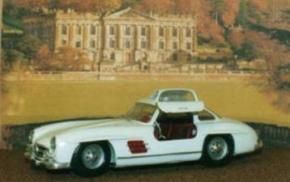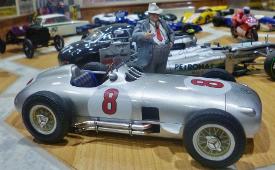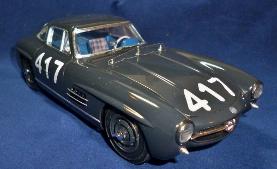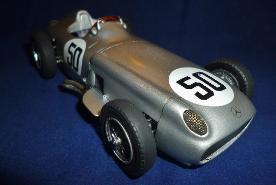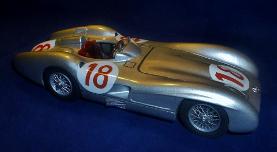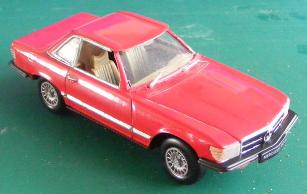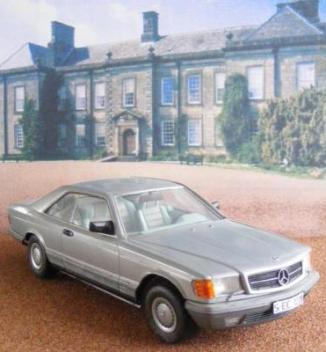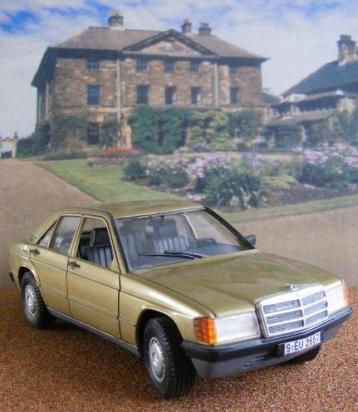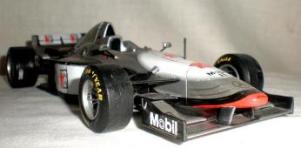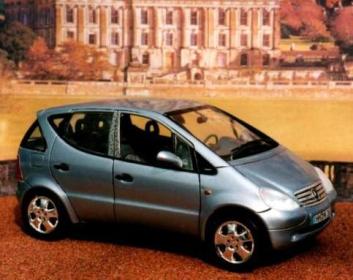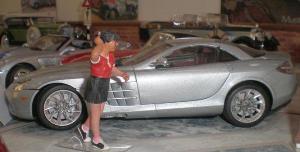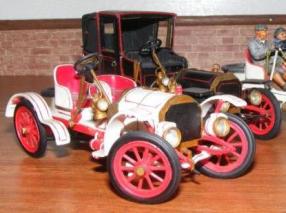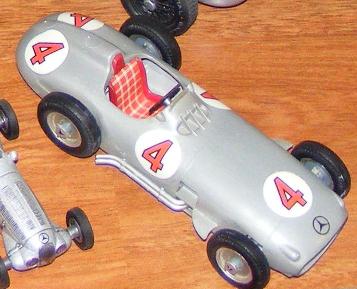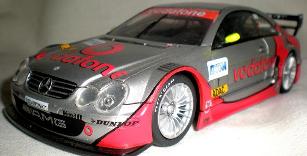The Mercedes-Benz collection
Karl Benz is often credited as the inventor of the gasoline powered automobile and was one of the pioneers of automobile manufacturing. Benz patented his work before anyone else and patented all of the processes for making the internal combustion engine practical in cars. Benz' company would merge with that of competitor Gottlieb Daimler's Mercedes firm and give the world one of it's most highly respected and enduring brands.
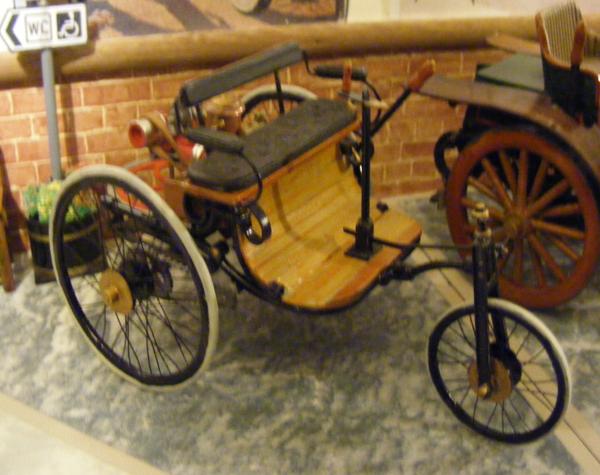
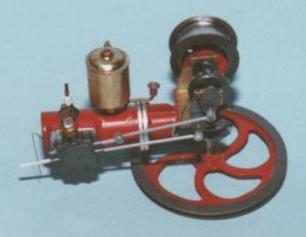
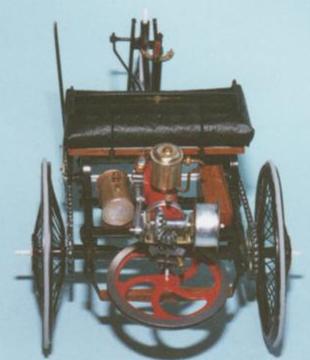
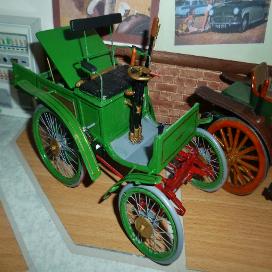
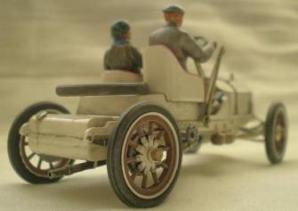
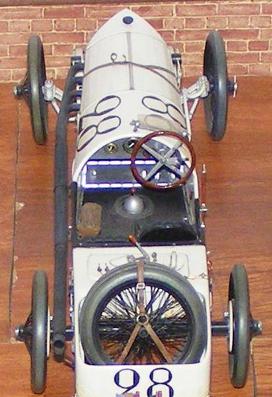
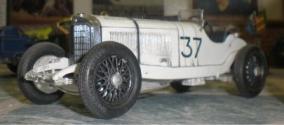
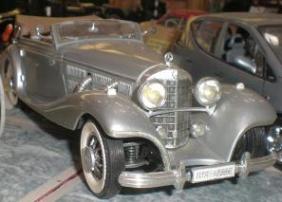
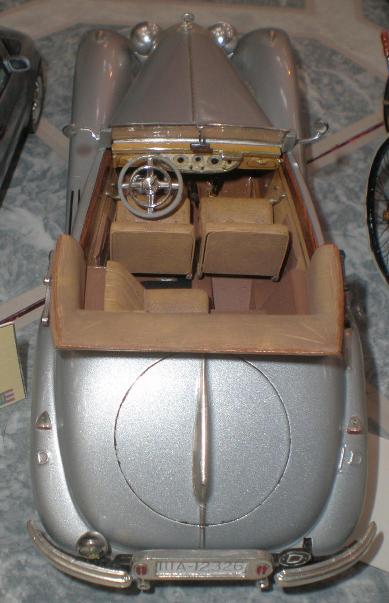
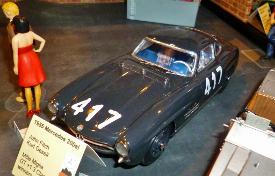
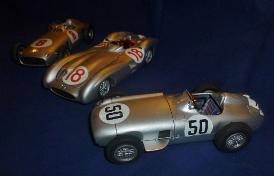
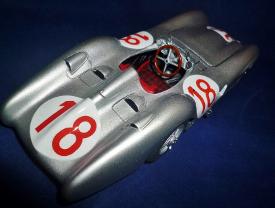
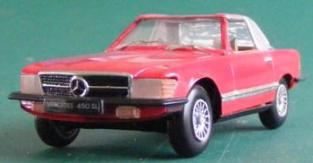
1981 Mercedes Benz 500SEC
1/24th scale Tamiya kit.
The release of the 500SEC Coupe again proved that Mercedes were leaders in the field of first class luxury cars. This hard-top coupe has wide doors to make access to all seats very easy. Rear passengers have more leg room than before due to re-designed front seat backs. When the doors are closed and the ignition are turned on, the seat belts are automatically moved towards the driver and the front seat passenger by belt guides. After being fastened the guides retract to their rest position.
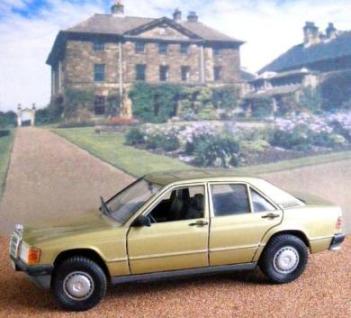
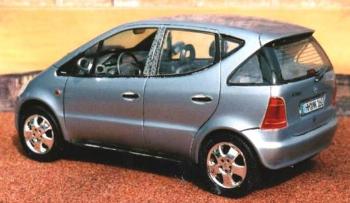
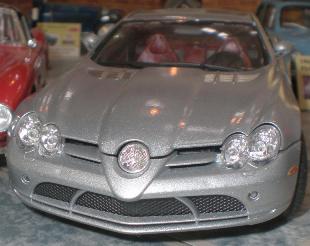
Never mind who invented the car, cars are not invented- they tend to develop.
But, if we have to blame someone......
Carl Benz made his first car 1885 & continued for 15 years - a long run (even by today’s standards) but then there was very little competition. Benz showed a remarkable soundness of design and later showed a remarkable obstinacy to improve or develop it.
Benz sold his first car in 1887 and had 50 employees by 1888.
The Benz patent application documents are considered the birth certificate of the motorcar.
Benz’ engine a single cyl. of 948 cc. Developed 0.9 hp. at 400 rpm. Giving a top speed of 9.3 mph. It was a stationary gas engine adapted to liquid fuel with electric ignition. The design became a widely used and licensed unit driving many of the early manufacturers cars.
To see details of the scratch build of this car visit the Articles and Projects page.
1903 69hp sports car
which won the Gordon-Bennett international trophy that year. Another conversion from the Airfix kit.
1904 Mercedes 1/32 scale Airfix kit
This car is considered the first real sports car our model boasts steering front wheels, impressive for a model built in the 1960s.
Sitting behind the 1904 car is a conversion from the Airfix kit which provided us with a
1906 18hp Landaulette.
1914 GP car 1/16th scale Lindberg kit.
The 1914 French GP saw a team of Mercedes cars with a specific plan to win the race. It started with preparing each cars to the driver and mechanics preferences so each car was different. Our model portrays the winning machine of Christian Lautenschlager.
Motor racing has been at the heart of Mercedes since its birth and usually they won too! 1928 Mercedes S-Series helped continue this history. In 1931, the worst year of the Great Depression, the 720 SSKL ( Super Sport Kurz Leicht ) was introduced. The SSK chassis lost 200kg in weight after being bored through several times. The engines swept volume remained unchanged, but the compression ratio was increased to 7:1. The power output of 300 hp was quite remarkable.
1931 Mercedes SSKL
1/32nd scale matchbox kit conversion.
Although Mercedes had withdrawn their factory team from motor racing due to the economic climate they did sell cars to those who could afford them for racing. One such driver was the legendary "regenmeister".
1931 Rudi Caracciola ran his own SSKL through the European season and won every race he entered, an astounding feat for the time, especially considering the variety of the events from the Mille Miglia to this, the winner of the German Grand Prix.
1934 Mercedes-Benz W25
1/43rd scale restored Dinky model.
1937 Mercedes-Benz W125
1/43rd scale NewRay kit.
These two GP cars, the W25 & W125 were also winning cars in the thirties. Before Auto Union started to provide stiffer opposition.
1939 Mercedes W154-M163.
1/20th scale detailed Revival kit.
The 1939 GP Mercedes fought tooth and nail with German rivals Auto Union for the second half of the 1930’s, both teams could call upon the services of the great drivers of the day. In Mercedes case Caracciola, Von Brausitch Seaman and Lang.
This model represents Rudi Caracciola's car with which he won the 1939 German GP.
1938-56 Mercedes 170v
Airfix 1/24th scale kit.
First shown in 1935 the 170v was available in many different body forms. It was followed by the 540 series.
1939 Mercedes-Benz 540-K
1/24 scale Monogram kit.
Hans Nibel succeeded Porsche as Chief Engineer in 1928 and under him the sporting machines became more refined and elegant.
The last in the series of great supercharged sports cars, the 540K (540 for 5.4 litre capacity, K for Kompressor) in production from 1934-39. Most attractive of all the bodies was the works own 2-seater roadster.
8-Cylinder in-line 5401cc engine developed 115 hp, boosted to 180 hp by the supercharger. Bosch vacuum power assisted Hydraulic brakes. Independent. Springing all round. Weight 3 tons. Top speed 105.6 mph.
1952 Mecedes-Benz W194 300SL
1/43rd scale NewRay kit.
The W194 sports racing car was designed and built in 9 months. May of the parts came from the companies newest 300 series car; a decidedly unsporting design! I didn't stop Rudolph Uhlenhaut and his team from designing a car that would be the foundation a 5year spell of motor racing domination for Mercedes-Benz.
1954 Mercedes-Benz 300 SL
1/24 scale Heller kit.
The 300SL Gullwing. In 1945 production began on another historic vehicle, the 300SL, which was developed from the competition version of the same name. For the first time a direct fuel injection system was used. One of its distinctive features was its gull-wing doors, but these disappeared in 1957 with the introduction of the roadster version.
1954 Mercedes W196
1/24th scale Merit kit.
1954 saw Mercedes come back into GP racing for two seasons & once again they dominated. The engine was inclined at a steep angle of 20 degrees to the horizontal. It produced 260bhp at 8000 rpm and was the first to have desmodromic valves, mechanically closing rather than by use of springs. A system recently adopted by Ducatti in their motorcycle race engines.
At the end of the 1955 season they withdrew in a sombre service after the events of the 1955 le Mans crash.
Merit produced a simple but nice model of the W196 in the late ‘50’s, this model was made around that time.
1955 Mercedes-Benz 300 SL Mille Miglia
1/24th scale FROG kit.
While everyone was saluting Stirling Moss and Dennis Jenkinson on smashing the winning time for the Mille Miglia, John Fitch and Kurt Gesell stole home just 84 minutes behind them in what was basically a production road car with the bumpers taken off.
Fitch raced home in a time that was just 2 mins shy of breaking the winning time of the 1954 Mille Miglia set by a racing Lancia D24. It was an astonishing achievement which cemented the 300SL in the Mercedes catalogue and sold hundreds of these cars to racers, movie stars and the rich and playful people of California.
1969 Benz C111 Prototype
1/24th scale Arii kit.
The first version of the C111 completed in 1969 used a fibreglass body shell and had a three-rotor direct fuel injected Wankel engine (code named M950F) mounted in the middle. The next C111 appeared in 1970. It used a four-rotor engine producing 370 hp (275 kW). The car could reportedly hit 180 mph (290km/h).
1971 Mercedes 450SL hard top
1/43rd scale Heller kit.
The Mercedes SL sportscars arrived in 1971 replacing 230/250/280SL range that had been in production since 1963. The 450SL V8 engined versions was larger and heavier than the earlier cars but retained the thoroughbred lines and classic styling. A convertible soft-top was standard although a metal hard-top was available.
The 450SL used the larger 4520cc V8 engine which was usually with an automatic ’box. S-Class suspension was used for improved ride comfort in keeping with the overall shift towards luxury in the SL range.
Mercedes Benz 500SEC
Double door seal and bulkheads keep noise levels to a minimum. The dashboard layout has been improved with new instruments, switches and levers more obvious in their function.
The Mercedes 190E
1/24th scale ESCI kit.
The Mercedes-Benz 190E was a sports sedan compact aimed at executives. It was replaced in 1993 by the C-Class.
Dubbed "the Baby Benz" the 190 was the most affordable model in their range, amongst the items that were a first for Mercedes was the 190's patented 5-link suspension at the rear.
It had anti-roll bars front and rear, anti-dive and anti-squat geometry, and was available with airbags, ABS brakes, seatbelt tensioners, and other advanced safety features.
The 2.6Ltr straight 8cyl engine model was produced in 1986. This produced 160 bhp and being a straight six, it had a smoothness lacking in the four-cylinder engines.
1997 McLaren Mercedes MP4-12
1/24th scale Revell kit.
Mercedes involvement in F1 was re-established when they provided engines for McLaren from 1995.
By 1997 Mercedes were a main sponsor and the team colour scheme reflected the "Silver Arrows" heritage.
This is David Coulthard's MP4-12 from the 1997 French GP.
Mercedes involvement in motor sports goes beyond Grand Prix racing but whenever they race Mercedes are there to win.
During 2000-2003 Bernd Schneider was on top form, winning three titles in four years and second the year he didn't win.
Revell's series of 1/32nd scalt DTM cars are aimed at the less experienced modellers. They have prepainted bodies but with some careful touching up and detail painting they build into very nice models. This is the 2002 CLK-DTM car.
1998 Mercedes A160
1/24th scale Revell kit.
The A160’s front engine, front wheel drive layout was quite unusual for Mercedes. The innovative frontal-impact absorption system, called the "Sandwich", is so designed that in the event of a crash the engine and transmission would go underneath the floor and below the pedals rather than entering the cabin. It became infamous in 1997 after crashing in the a traditional "moose test" in Sweden. According to reports the car overturned when turning sharply to avoid the "moose". After initially denying the problem, Mercedes recalled 2,600 and stopped sales until the problem was solved. They installed electronic stability control and modified the suspension. This was the first time stability control was used in a small car.
2003 Mercedes-Benz SLR
1/24th scale Tamiya kit.
The 2003 Mercedes-Benz SLR McLaren is an Anglo-German project jointly developed by Mercedes-Benz and McLaren Automotive at the McLaren Technology Centre in Woking.
SLR stands for "Sport, Leicht, Rennsport" (sport, light, racing).
The automatic gear box, front mid-engined arrangement, and driving characteristics mean it could be classified as a GT putting it on a par with the Aston Martin DBS V12 and Ferrari 599 GTB Fiorano.
2010 Mercedes F1 W01
1/24th scale Revell kit.
Out of the ashes of Hondas F1 odyssey arose the team pulled together by Ross Brawn, and Brawn won the F1 constructers and World drivers championship in 2009. This outstanding achievement lead Mercedes to move from engine supplier to the team to actual team owners.
Our model shows the car as driven to third place by Nico ROsberg at the Chinese GP. Only the third race for this new team. History now waits to see how this new endeavour develops.
